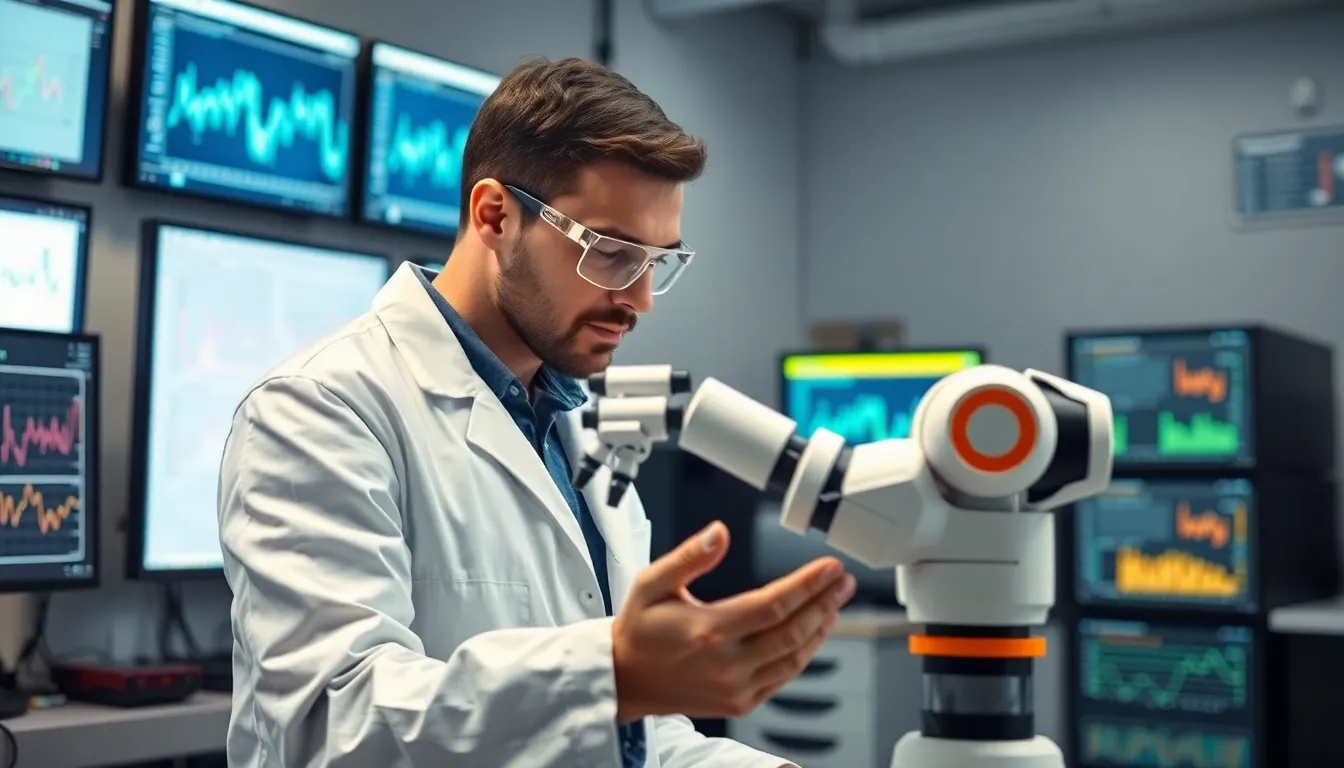Imagine a world where robots not only follow commands but learn and adapt like humans. Welcome to the fascinating realm of robot learning, where machines evolve from clunky metal boxes into intelligent companions. No longer just the stuff of science fiction, this technology is transforming industries, enhancing everyday life, and maybe even making your coffee just right—finally!
Table of Contents
ToggleOverview of Robot Learning
Robot learning refers to the methods and techniques through which robots acquire knowledge and skills. Machine learning plays a crucial role, enabling robots to analyze data and improve their performance over time. Reinforcement learning helps robots understand complex tasks by learning from their actions and outcomes. These techniques allow robots to adapt to their environments, making them more efficient and effective.
An array of applications emerges from robot learning. In manufacturing, robots streamline production processes by optimizing workflows. In healthcare, robotic systems assist with patient care and medical procedures. Delivery robots enhance logistics by ensuring timely distribution of goods. Each of these instances showcases the adaptability of robots in various scenarios.
Real-world examples highlight the benefits of robot learning. Autonomous vehicles utilize machine learning to navigate and respond to dynamic road conditions. Social robots, designed for interaction, learn from user behavior and preferences, fostering better communication. Smart home devices use robot learning to personalize user experiences, enhancing convenience and comfort.
The impact of robot learning on industries proves significant. Efficiency improvements lead to cost reductions and enhanced productivity. Enhanced precision leads to fewer errors in complex tasks. As robot learning technology advances, its integration into daily life expands, paving the way for sophisticated applications.
Robot learning continues to evolve, driving innovations that shape the future. The convergence of artificial intelligence and robotics opens new avenues for exploration and development, transforming how tasks are performed and experienced.
Types of Robot Learning

Robot learning encompasses various methods that enable machines to acquire skills and knowledge. Three primary types include supervised learning, unsupervised learning, and reinforcement learning.
Supervised Learning
Supervised learning involves training robots on labeled data. This type of learning requires a dataset containing input-output pairs, guiding the robot in making predictions. In practical applications, robots analyze examples to identify patterns and generalize from them. Supervised learning excels in tasks like image recognition and natural language processing. For instance, a robot trained to recognize objects can effectively categorize images based on learned labels. As data availability increases, the potential for supervised learning in robotics expands, enhancing accuracy and functionality.
Unsupervised Learning
Unsupervised learning focuses on finding hidden patterns in unlabeled data. In this approach, robots explore data without prior knowledge of outcomes. Clustering and dimensionality reduction often highlight the relationships within datasets. For instance, a robot might group similar sensory inputs, allowing it to identify new objects or environments. This method proves beneficial when labeled data is scarce or expensive to obtain. Therefore, the ability to adapt and learn from raw data enhances the robot’s flexibility and capabilities.
Reinforcement Learning
Reinforcement learning teaches robots through trial and error. Here, agents learn to make decisions by receiving rewards or penalties based on their actions. Robots optimize their behavior by exploring different strategies, gradually improving performance. Real-world examples, such as robotics in gaming or autonomous driving, demonstrate how reinforcement learning facilitates complex decision-making. This method enables robots to adapt to dynamic environments and continually refine their approaches. Consequently, the application of reinforcement learning opens doors to innovative robotic solutions across industries.
Applications of Robot Learning
Robot learning finds applications across various industries, enhancing efficiency and effectiveness in numerous tasks.
Industrial Robotics
Industrial robots utilize learning algorithms to streamline production processes and improve quality control. These robots analyze data from sensors and cameras, adjusting operations in real-time for optimal performance. For instance, they adapt to variations in assembly tasks, increasing precision in manufacturing environments. Machine learning aids in predictive maintenance by identifying potential equipment failures, reducing downtime and repair costs. Adopting robot learning in factories leads to higher productivity levels and lower operational expenses.
Autonomous Vehicles
Autonomous vehicles rely on sophisticated learning techniques to navigate complex environments safely and efficiently. Through reinforcement learning, these vehicles make real-time decisions based on continuous feedback from their surroundings. They analyze data from cameras, LIDAR systems, and GPS to enhance driving accuracy and obstacle detection. As a result, the integration of robot learning improves road safety and optimizes traffic flow. Companies investing in autonomous driving technology benefit from reduced transportation costs and increased efficiency in logistics.
Service Robots
Service robots leverage robot learning to provide assistance across various sectors, including healthcare and hospitality. These robots recognize and respond to human emotions, creating more interactive user experiences. For example, they can aid elderly patients by monitoring health and offering companionship, improving overall well-being. Additionally, in hospitality settings, robots learn to perform tasks such as room service and check-ins, enhancing customer satisfaction. The implementation of these intelligent systems results in streamlined operations and better service quality.
Challenges in Robot Learning
Robot learning faces several obstacles that can impede development and deployment. Addressing these challenges is crucial for creating reliable and effective robots.
Data Availability
Data availability presents a significant hurdle in robot learning. Training algorithms require extensive datasets, yet many real-world scenarios lack sufficient labeled data. Sparsity in data can hinder learning capabilities because limited information restricts a robot’s ability to generalize. Additionally, data needs to be diverse and representative of various environments to enhance robustness. Without adequate datasets, robots struggle to perform optimally in unfamiliar situations. Efforts to generate synthetic data or utilize transfer learning can help, yet these methods require further research and validation.
Real-World Adaptability
Real-world adaptability remains a challenge in deploying robots. Robots often encounter unpredictable environments where their training may not fully prepare them for unique situations. Variations in lighting, obstacles, and human interactions complicate decision-making processes. Dynamic environments necessitate the ability to learn continually, but not all robots possess this capability. Implementing robust algorithms that allow for on-the-fly adjustments improves their performance. Moreover, strategies that combine simulation training with real-world experience enhance adaptability significantly.
Safety Concerns
Safety concerns pose another challenge for robot learning. Robots operating in human environments must prioritize safety to avoid accidents or injuries. Implementing fail-safes and ensuring compliance with safety standards are essential for acceptable operation. Unpredictable behavior can arise from unforeseen inputs or learned behavior discrepancies. Manufacturers and developers must conduct thorough testing and validation to minimize risks. Increasing the transparency of decision-making processes can help build trust and ensure that robots operate safely alongside people.
Future Trends in Robot Learning
Advancements in artificial intelligence influence future trends in robot learning significantly. Rise in deep learning techniques enhances robots’ capability to process and analyze vast amounts of data. Today, robots are set to benefit from improved algorithms that facilitate real-time decision-making.
Increased collaboration between humans and robots marks a notable trend. Development of human-robot interfaces fosters seamless interaction, enabling smarter task delegation in environments such as warehouses and hospitals. Robots equipped with natural language processing demonstrate greater adaptability in communicating with humans.
Growing interest in ethical considerations shapes the field of robot learning. Researchers actively explore frameworks that ensure safe and responsible deployment of robots. Emphasis on ethical standards anticipates addressing potential biases in algorithms and promoting inclusivity in robotic applications.
Integration of robotic learning systems with the Internet of Things enhances the overall efficiency of smart environments. Improved connectivity allows robots to gather data from various sources, facilitating coordinated actions and optimizing operations in sectors like logistics and agriculture.
Expansion of cloud-based learning platforms paves the way for more advanced remote robot learning. Utilizing shared resources reduces the need for extensive on-site data collections, accelerating the training process.
Market demands propel competition in robot learning solutions, pushing for innovations in efficiency and functionality. Companies prioritize developing multi-functional robots that can adapt to numerous tasks, enhancing their appeal in various industries.
A future driven by continuous improvement in robot learning emphasizes the significance of lifelong learning models. Technologies that enable robots to learn from ongoing experiences will redefine operational capabilities within diverse environments.
Robot learning is reshaping the landscape of technology and human interaction. As robots become increasingly capable of learning and adapting, their applications span various industries, enhancing productivity and user experiences. The integration of advanced learning techniques like reinforcement learning enables robots to navigate complex tasks efficiently.
While challenges such as data availability and safety must be addressed, the future of robot learning looks promising. Innovations in artificial intelligence and collaborative interfaces will likely lead to smarter robots that work seamlessly alongside humans. As research continues to evolve, the potential for robots to transform daily life and industry practices remains vast. Embracing these advancements will be crucial for harnessing the full benefits of robot learning in the years to come.



